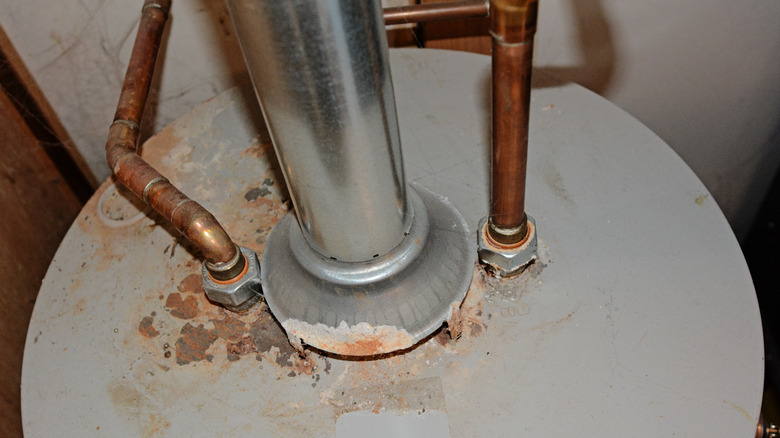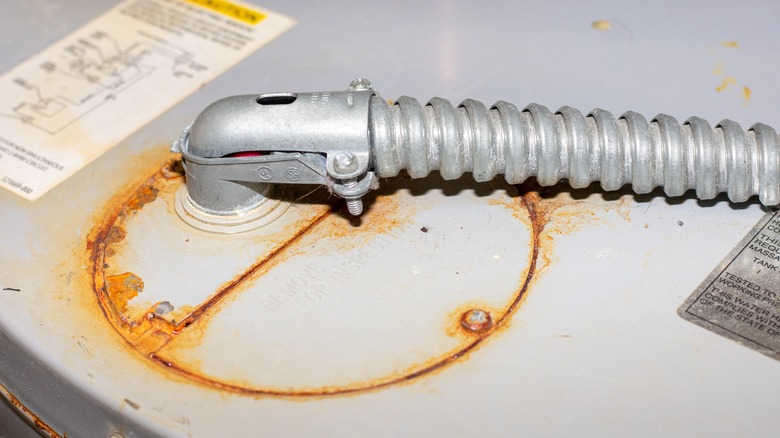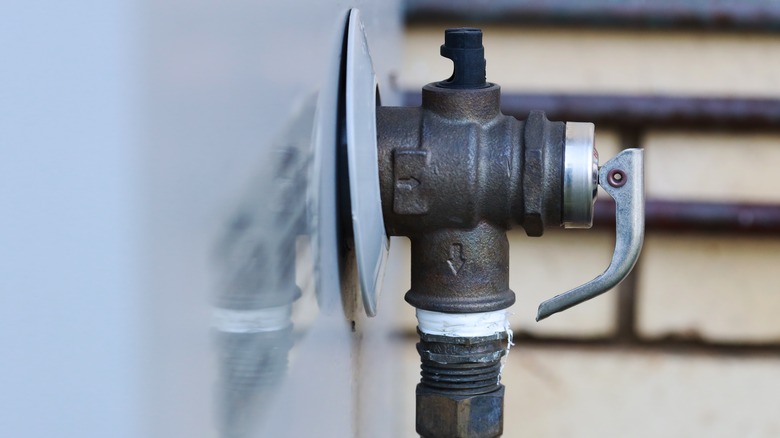How The Location Of Rust On Your Water Heater Can Help Identify The Issue
Rust is never exactly a good sign, but when it shows up on part of your plumbing — most likely a water heater — you have plenty of reason to be concerned. Rust anywhere on or in a water heater is a sign that something is amiss. On the outside of the water heater, rust could be pointing you to the imminent failure of the device. Rust on the inside, probably noticed in the water coming from your taps, also suggests potential failure, with the added danger of possible acute iron toxicity ... rust poisoning. House Digest spoke exclusively with Chuck Pound, Virtual Plumbing Expert at Frontdoor, about the meaning and dangers of rust on or in a water heater. "Seeing rust on a water heater is a good sign that there is a leak of some kind," Pound said, "or the conditions inside the tank and/or its piping are at risk of damage."
Sometimes your course of action will be a DIY repair, and sometimes you need to call in a professional. Occasionally, rust forms on a part of the water heater that can't be repaired, and it might be necessary to replace the unit. "Rust is a warning sign in most cases and is a good reason to replace a heater over the manufacturer's life expectancy," Pound said, adding that water heater life expectancy is typically 10-12 years for most brands. He indicated that homeowners should inspect water heaters for rust once a year or more.
What rust on the inside and outside of a water heater means
Where you find the rust in your hot water, plumbing expert Chuck Pound exclusively told House Digest, you're exposing yourself and your family to rust that can cause health problems, discolor your laundry, and cause other issues. "In most cases of rust in the hot water, a simple tank flush will fix the problem," Pound said. "If the rust is still present after the flush, you may need a new heater or a professional to track down the cause." Water heater replacement typically costs between $829 and $1,642.
Rust on the outside of your water heater (or collecting in its drain pan, a critical component for avoiding water damage), can point to specific problems with the unit, but it doesn't always mean a leak. "In some cases, the environment where the heater is stored plays a role in this happening," Pound said. "It is best to remove the rust when you notice it there, to avoid further rust from forming." Homeowners can remove rust as part of routine cleaning of dust and dirt that accumulates on the water heater, but Pound warns that there's cause to be cautious. "Always read safety warnings on chemicals and use caution when applying them," he said. "Never use flammables to clean water heaters or appliances, and spray wet cleaners on a rag to wipe rather than directly on the unit."
What rust on specific areas means
You can get some clue as to what, if anything, ails your water heater by noting the location of rust. When you find it on top of the water heater, Frontdoor Virtual Plumbing Expert Chuck Pound told House Digest exclusively, it could point to a simple loose fitting, leaky pipe, or even a roof leak above the water heater. "Wet rust on top of the heater is more than likely an active leak and needs immediate attention," he cautioned.
If you find rust on or around the temperature & pressure (T&P) relief valve, it's urgent to both look for a leak and to check out the valve itself. "This is a safety device and should be tested if rust is found on or around it," Pound said. "It is a good idea to test this valve at least once a year."
Rust on external heat exchangers or sidearm heat exchangers are another red flag warning of a possible leak that should be fixed right away, Pound said, adding, "If it is leaking, it can lead to more costly repairs if ignored."


